Things to do in Phoenix
Phoenix shimmers in the heat of the biologically unique Sonoran desert in central Arizona. For decades people have chosen to travel to Phoenix for the sunshine, and found a modern metropolis with a thriving tourist district, an art neighbourhood packed with galleries, and a number of fascinating natural and historical attractions. The city offers some good sightseeing and a great restaurant scene, but most travellers use Phoenix primarily as a travel hub for excursions into the glorious desert landscapes on the city's doorstep. Within the city, popular sights include the Heard Museum, the Desert Botanical Garden, St Mary's Basilica, and Taliesin West, the former home and school of renowned architect Frank Lloyd Wright.
Travellers are spoilt for choice when it comes to excursions, as Camelback Mountain, South Mountain Park, Piestewa Peak, and many other scenic spots lure hikers and photographers just beyond the city. Many people choose to travel further afield on a day trip to famous attractions such as the Grand Canyon, Lake Mead and Hoover Dam. Golfers are very well catered for through Phoenix's scenic courses, and there are many spas and health resorts for those who enjoy pampering. Hikers can enjoy excursions to the surrounding mountains.
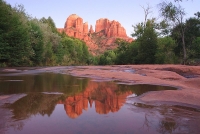
Sedona
Sedona is one of the most striking geographical locations in the US. Located in the heart of Red Rock Country, the sandstone cliffs and plateaus provide a stunning backdrop for thi…
Sedona
Sedona is one of the most striking geographical locations in the US. Located in the heart of Red Rock Country, the sandstone cliffs and plateaus provide a stunning backdrop for this small yet bustling town. Only 120 miles (193km) north of Phoenix, Sedona is fast becoming one of Arizona's top holiday destinations.
Sedona is a paradise for outdoor activity. Visitors can mountain bike, quad bike, hike, rock climb, horseback ride, and camp to popular trails such as the Broken Arrow, Cathedral Rock, Devil's Bridge, Bell Rock, and Soldier's Pass.
A unique attraction of Sedona is its reputation as the site of the confluence of five large vortexes. It is said that the strong magnetism of the earth in Sedona has natural healing properties. As a result the city has a thriving New Age medicine industry.
Visitors will find a multitude of spas, herbalists, healers and spiritual guides. The vortices are said to be concentrated at Bell Rock, Airport Mesa, Cathedral Rock, Boynton Canyon, and Schnebly Hill, and there are many guided tours of these sites available from Sedona.
Shopping in Sedona offers a number of stores filled with Native American arts and crafts as well as New Age shops stocking crystals and healing products. For the culture lovers, Hozho Plaza is home to a number of art galleries, featuring local artists' sculptures, paintings, and jewellery.
Tourists eating out have a variety of restaurants and bars to choose from, catering to every budget and taste, some rated among the best in Arizona. Whether travellers journey to Sedona for the thrill of climbing the cliffs and diving into the rock pools, or to be soothed and pampered in a local spa, Sedona receives and accommodates all.
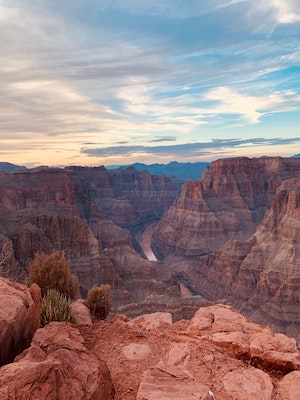
The Grand Canyon
A mile deep, 277 miles (446km) long, and up to 18 miles (29km) wide, the breath-taking grandeur of the Grand Canyon is so impressive that words simply cannot do it justice. One of …
The Grand Canyon
A mile deep, 277 miles (446km) long, and up to 18 miles (29km) wide, the breath-taking grandeur of the Grand Canyon is so impressive that words simply cannot do it justice. One of the great natural wonders of the world, it was formed by the cutting action of the Colorado River over millions of years. The hard rock formations survive as great cliffs, pinnacles and buttes, and the different layers of rock span a range of colours, from purple, fiery-red and pastel-pink to yellow, brown, grey and soft tones of blue.
Whether by foot or on horseback, from a plane or helicopter, aboard a raft down the mighty Colorado River or by merely gazing in awe from the rim, the canyon's seemingly infinite depths can be experienced in a variety of ways and is a sight not to be missed however visitors choose to see it. The park receives hordes of visitors from around the world, who never fail to be transfixed by the sculpted rock shapes, the shifting colours that change with the light, and a tiny glimpse of the Colorado River far below.
The Grand Canyon National Park comprises two separate areas: the South Rim and the more remote North Rim. Separated by the 10-mile (16km) width of the canyon, it is a 215-mile (346km) drive from one Visitor Centre to the other. The South Rim is the most accessible and has more facilities, and as a result it attracts the bulk of visitors to its boundaries. The North Rim is higher in elevation, wetter, with thicker surrounding forests, is more remote, and is cut off by snowfall from October to May. Many people, however, prefer its comparative peacefulness and less-crowded lookouts.
Grand Canyon West has recently opened the Grand Canyon Skywalk, a glass-bottomed, horseshoe shaped deck that juts almost 70 feet (21m) from the canyon's rim. It gives visitors the sensation of being suspended amid the canyon's towering red rock walls above a faint sliver of Colorado River flowing 4,000 feet (1,219m) below. There is an additional charge for the Skywalk, which is not for those with a fear of heights. Another great way to tour the Grand Canyon is on the Grand Canyon Railway, a vintage steam train that winds its way around the area.
Both rims have numerous drives and walkways along the edge with various scenic viewpoints, and some hiking trails into the canyon where visitors can overnight at Phantom Ranch on the canyon floor. The impact of more than four million visitors a year to the South Rim, especially during the busy summer months, is one of overcrowding and traffic congestion; but seeing the most spectacular examples of natural erosion in the world more than makes up for any inconvenience.
There are also several educational and cultural attractions at the Grand Canyon, including the Tusayan Museum and Ruin (near Desert View), the Yavapai Museum of Geology, and the Verkamps Visitors Center.
Website www.nps.gov/grca
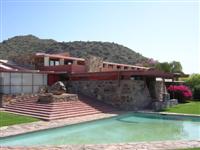
Taliesin West
Taliesin West was legendary architect Frank Lloyd Wright's winter home and school from 1937 until he died in 1959, aged 91. Today the facility can be visited as the Frank Lloyd Wri…
Taliesin West
Taliesin West was legendary architect Frank Lloyd Wright's winter home and school from 1937 until he died in 1959, aged 91. Today the facility can be visited as the Frank Lloyd Wright Foundation, with tours providing a general introduction to Wright and his hugely influential theories of architecture. The building has been constructed with the natural stone of the region, a reflection of Wright's philosophy that local materials should be used in design wherever possible. There are a range of tours available to suit the visitor's level of interest. For the rookie, a basic introductory tour is recommended, while devotees will want the behind-the-scenes exposé.
Website www.franklloydwright.org
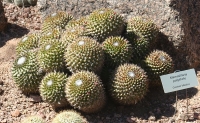
Desert Botanical Garden
The Desert Botanical Garden gets high ratings not only for the size and range of its collection, but also the inventive ways visitors can immerse themselves in the desert. With abo…
Desert Botanical Garden
The Desert Botanical Garden gets high ratings not only for the size and range of its collection, but also the inventive ways visitors can immerse themselves in the desert. With about 21,000 plants representing 139 species, the Desert Botanical Garden was founded in 1939 to provide a fascinating and colourful introduction to the ethnobotany of the region. A highlight is the Plants and People of the Sonoran Desert Trail, which allows visitors to make their own yucca-fibre brush and grind corn as the Native Americans once did. Over November and December the gardens are lit up at night by beautiful luminarias (candles inside small bags), meaning plenty of worthy photography material.
Website www.dbg.org
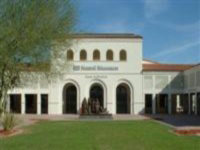
Heard Museum
The Heard Museum is home to America's finest collection of Native American art, making this an essential attraction for visitors looking to gain an understanding of the country's o…
Heard Museum
The Heard Museum is home to America's finest collection of Native American art, making this an essential attraction for visitors looking to gain an understanding of the country's original inhabitants. In total there are more than 39,000 works of cultural and fine art ranging across textiles, katsina dolls, pottery, jewellery, baskets, cradleboards, paintings, and sculpture. There are about 10 galleries with dynamic and imaginatively curated exhibitions. Visitors shouldn't miss the annual Guild Indian Fair and Market (March), which includes traditional dance performances along with arts and crafts. The museums signature exhibitions are 'Home: Native People in the Southwest' and 'Away from Home: American Indian Boarding School Stories'.
Website www.heard.org
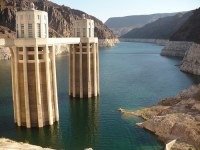
Lake Mead and Hoover Dam
The 1.5 million acre Lake Mead Recreation Area was created in 1936 as part of Roosevelt's New Deal programme. A popular excursion from Las Vegas or even Phoenix, Lake Mead is a hav…
Lake Mead and Hoover Dam
The 1.5 million acre Lake Mead Recreation Area was created in 1936 as part of Roosevelt's New Deal programme. A popular excursion from Las Vegas or even Phoenix, Lake Mead is a haven for outdoor recreation such as boating, swimming, canoeing, fishing, waterskiing, lake cruises, and even scuba diving. Five marinas ring the lake, ranging from small family-owned operations such as Hemingway Harbor to large resorts such as Forever Resorts at Callville Bay.
The rest of the shoreline of Lake Mead is made up of rocky coves and sandy beaches good for sunbathing. Land-based activities such as camping and hiking are available in the surrounding area. The Alan Bible Visitor Center, also known as the Lake Mead Visitor Center, provides information about activities and resources at Lake Mead. There are also some educational exhibits, including a garden of cactus plants native to the Mojave Desert. Lake Mead is formed by the giant Hoover Dam, a popular tourist attraction. Attracting nearly 3,000 people each day, Hoover Dam is an engineering marvel, standing 726 feet (221m) tall and 1,244 feet (379m) wide. The enormous dam supplies 90 percent of Las Vegas' water, and visitors can take guided tours of the facility.
Website www.nps.gov/lake/index.htm
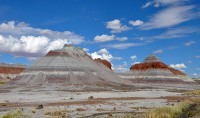
Petrified Forest National Park
Located in the northeastern corner of Arizona, Petrified Forest National Park was designated a national monument in 1906. The trees within the park are over 225 million years old, …
Petrified Forest National Park
Located in the northeastern corner of Arizona, Petrified Forest National Park was designated a national monument in 1906. The trees within the park are over 225 million years old, and have over that period transformed into brilliantly-coloured minerals, the world's largest concentration of petrified wood. Aside from the trees, there is a variety of wildlife to see in the park, including bobcats, coyotes, owls, porcupines, mule deer, and various desert lizards and rodents. There are several trails leading to popular sites in the park, making it a great place for desert hiking. Visitors should be aware that it is illegal to remove petrified wood from Petrified Forest National Park.
Website www.nps.gov/pefo/index.htm
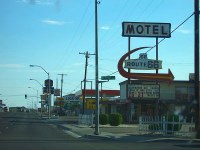
Kingman
Kingman is a nostalgic tourist destination in Arizona. Located in the northeastern corner of the state, between the Grand Canyon and Las Vegas, the city is a popular fuelling stop …
Kingman
Kingman is a nostalgic tourist destination in Arizona. Located in the northeastern corner of the state, between the Grand Canyon and Las Vegas, the city is a popular fuelling stop between the two destinations. However, Kingman is most famous for having been a major stop along the celebrated Route 66. There are a few old buildings and museums dedicated to this era, including the aptly named Route 66 Museum, and though most of the road has been replaced by Interstate I-40, the longest remaining stretch runs from Kingman to Ash Fork. There are some good restaurants and bars in Kingman and wonderful hiking can be enjoyed in the area.
Website www.gokingman.com
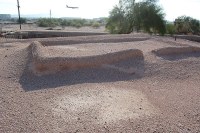
Pueblo Grande Museum and Archaeological Park
Located surprisingly close to downtown Phoenix, the Pueblo Grande Museum and Archaeological Park is the site of the remains of a 1,500-year-old Hohokam village. The site is a Natio…
Pueblo Grande Museum and Archaeological Park
Located surprisingly close to downtown Phoenix, the Pueblo Grande Museum and Archaeological Park is the site of the remains of a 1,500-year-old Hohokam village. The site is a National Historic Landmark and the largest preserved archaeological site in the region. Mysteriously abandoned around 1450, all that remains of the village is enclosed in a small museum with artefacts and exhibits showing daily life in the settlement. Hiking trails wind around the ruins and replicas themselves, so visitors should come prepared for the hot weather of southern Arizona. The site hosts the Pueblo Grande Indian Market each December, featuring more than 250 local artisans. For those who miss the market, there is a museum shop open year-round.
Website www.phoenix.gov/parks/arts-culture-history/pueblo-grande



